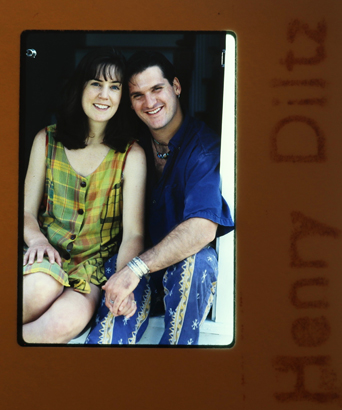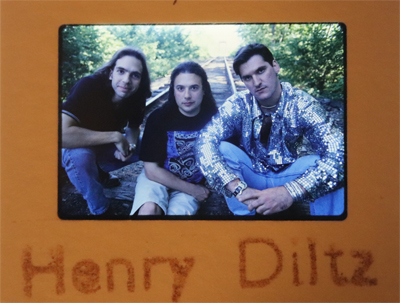Video
The Story of Chris Hobler
Lucky Man's Burden Lyric Video
Sonic Joyride 1997 EPK - Spencer Thornton
Sonic Joyride - "Baked" Music Video 1997
Sonic Joyride - Bus Top Montage
Sonic Joyride - Return to Deerwoord Farm 2024
Music
Explore the rhythm of our journey and the passion behind every note we play.
Christopher Wells Hobler (1965-2005):
A Legacy of Music, Hope, and Collaboration

Christopher Wells Hobler was just 36 when he received a life-altering ALS diagnosis in 2001. Refusing to succumb to hopelessness, Chris set out to transform the future of ALS research and funding. His visionary approach prioritized collaboration, a principle that would become the cornerstone of his legacy.
Chris founded ALS Hope-The Chris Hobler/James Maritz Foundation, later rebranded as Hope Happens-in partnership with Washington University School of Medicine in St. Louis. His bold initiative led to the creation of the Hope Center for Neurological Disorders, a groundbreaking institution dedicated to fostering interdisciplinary collaboration in the pursuit of cures for ALS and other neurological diseases. The center, which opened in November 2004, has since become a model of success, advancing research and treatment strategies that continue to offer hope to millions.
Under Chris's leadership, ALS Hope hosted the first Hope Summit in 2002, bringing together 18 ALS-focused organizations to promote cooperation and shared goals. The foundation funded numerous pioneering projects, including work by Dr. John McDonald, celebrated for his spinal cord therapy that helped Christopher Reeve regain movement. It also supported the ALS Hope Drug Discovery Center in Boston, the largest ALS drug screening facility in the world.
Before his journey as an advocate, Chris was an accomplished musician and entrepreneur. As the lead singer of Sonic Joyride, he released four albums and performed nationwide, earning accolades from MTV, CNN, and Billboard. Sonic Joyride's innovative grassroots tours and vibrant performances garnered airplay on over 180 college radio stations and endeared the band to a loyal fan base. Earlier in his career, his band Spamparis was named one of Boston's top unsigned acts, showcasing his ability to connect through music.
Chris's optimism never wavered, even in the face of ALS. "Happiness, purpose, and contentment come from between your ears, not from the circumstances around you," he said. He embraced his diagnosis as a call to action, determined to leave a legacy that transcended music and enriched the world through science and hope.
Chris passed away on February 16, 2005, at age 39, surrounded by loved ones. He is remembered by his wife Jennifer, their three children, and his extended family. His life exemplifies resilience, creativity, and a relentless commitment to bettering the world. Through the Hope Center and his enduring impact on the ALS community, Chris's vision lives on, inspiring progress and collaboration long after his passing.
History
The Story of Sonic Joyride
Sonic Joyride: A Legacy of Innovation and Musical Evolution
When one thinks of musical innovation, the typical destinations might be New York, Los Angeles, or Seattle. However, the story of Sonic Joyride began in an unexpected place: the scenic New Hampshire seacoast. Formed in 1989, the band was hailed as “a new alternative to the alternative,” thanks to their pioneering, genre-defying sound. Unafraid to challenge the norms of their time, Sonic Joyride built a lasting legacy from humble beginnings, driven by a devotion to forging their own musical path.
The early days of Sonic Joyride were shaped in Boston, where singer/guitarist Chris Hobler met bassist/synth player Rick Reese. Both shared a passion for pushing musical boundaries and initially formed Spamparis in the early '90s. With drummer Ed DiMuzio and David Flood completing the lineup, the band released their debut CD in 1992. Their unique sound earned regional airplay, critical acclaim, and recognition as one of Boston’s top unsigned bands. They were semi-finalists in Musician Magazine’s Best Unsigned Band Competition in 1993. Despite early success, creative differences led to the dissolution of Spamparis after the band relocated to New Hampshire.

In 1994, Hobler and Reese regrouped with DiMuzio to form Sonic Joyride. Their self-titled debut album, released on Anomaly Records in 1995, introduced a fresh alternative rock sound that was complex, innovative, and uniquely their own. As their music evolved, so did their lineup. DiMuzio played on the debut album but was succeeded by Paul Sahlin for the band’s second release, Bazaar. Sahlin’s drumming brought a new dimension to their sound, followed by Ken Tondre’s Texas-influenced contributions to the third album, Breathe. Their final studio album, Behemoth, featured renowned drummer Jonathon Mover. Each drummer added unique flavor to their evolving sound, while Chris and Rick remained the creative constants anchoring Sonic Joyride’s musical identity.
One of Sonic Joyride’s defining elements was their penchant for the unconventional—epitomized by their "bus top" concerts. The band transformed an old school bus into a mobile stage, complete with a 10,000-watt concert sound system, a full lighting rig, rear-projection video screens synchronized to their music, and a state-of-the-art 16-track digital recording studio. Memorable performances included a show outside the Ed Sullivan Theater on Broadway during a taping of The Late Show with David Letterman, a concert at the Golden Gate Bridge, and another at the World's Largest Ball of Twine in Cawker City, Kansas—where they were honored with the “key to the city.” These creative performances earned the band features on MTV News and CNN, as well as a spotlight in Mix Magazine (December 1997).
A Mission Beyond Music
Today, the Sonic Joyride Project carries on the legacy of the band’s groundbreaking work while honoring Chris Hobler’s visionary impact. Beyond music, the project is rooted in his pioneering efforts to promote collaboration in neurological research. Chris helped establish the Hope Center for Neurological Disorders at the Washington University School of Medicine, where he championed a research model built on collaboration among scientists, researchers, and patients.
The Sonic Joyride Project continues this mission by raising awareness for this revolutionary model, partnering with organizations dedicated to finding cures for neurological diseases, and generating critical funding to advance research.
The project also seeks to bring Chris’s voice and image back to life through innovative technology, sharing the music that has remained silent since the band’s premature exit from the scene. This unconventional tour celebrates Chris Hobler’s music, life, and story while championing the collaborative spirit he embodied. By sharing his legacy with a new generation, the Sonic Joyride Project aims to inspire change, carrying forward the dream of collaboration and the quest for cures to a global audience.
The player below features reinterpretations of classic Sonic Joyride songs, brought to life by the Sonic Joyride Project Band. Chris's music remains vibrant, and these renditions showcase the potential of celebrating his legacy during the upcoming concert, where the core band will perform these tracks live.
Constructed using original rehearsal recordings and live show samples, these demos prominently feature Chris's vocals and guitar playing, while new lead vocals and re-recorded bass guitar by Rick Reese (Sonic Joyride's original bassist) add a fresh dimension to the experience. These versions are conceptual and not intended for production.
We have access to the original master recordings, and we're committed to producing professional-level records and live shows that integrate Chris's contributions. Our mission remains clear to honor and include Chris in everything we do. These tracks offer just a glimpse into what is possible.
Listen to Our Tracks
I Know
Addiction
Bone
Psychadelic Cowboy
Team
Meet the dedicated and talented individuals who bring our mission to life.
Unstoppable
Discover stories of resilience, creativity, and the unstoppable spirit driving us forward.
Unstoppable Hope
Through Collaboration
Purpose Statement
Using music and real-life stories to raise awareness and funding for collaborative research for neurological disorders and other diseases, including cancer, to discover mechanisms that can be translated into cures and treatments